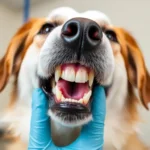
Aggression in dogs can be a concerning issue for many pet owners. Understanding why is my dog becoming aggressive is crucial for ensuring the safety and well-being of both the dog and the people around it. As a responsible pet owner, it’s essential to recognize the signs of aggression, identify the underlying causes, and implement effective management strategies. This article provides an in-depth look at dog aggression, its causes, and how to address it.
Understanding Dog Aggression
Definition of Aggression in Dogs
Aggression in dogs can be defined as a behavior that is intended to threaten or harm another animal or person. This behavior can manifest in various forms, including growling, biting, lunging, or barking aggressively. Understanding the different types of aggression is important for addressing the issue effectively.
Common types of aggression include:
- Reactive Aggression: Often occurs in response to a specific trigger, such as another dog or a loud noise.
- Fear-based Aggression: Results from a dog feeling threatened or scared, leading to defensive behaviors.
- Territorial Aggression: Happens when a dog feels the need to protect its home or belongings from perceived intruders.
- Social Aggression: Occurs during interactions with other dogs or people, often due to dominance or resource guarding.
Signs of Aggression
Recognizing the signs of aggression is key to preventing escalation. Behavioral indicators include:
- Growling: A warning sign that the dog is uncomfortable.
- Barking: Excessive barking can indicate frustration or aggression.
- Lunging: Moving aggressively toward a person or another animal.
Physical signs to look out for are:
- Body Posture: A stiff or tense body can indicate aggression.
- Facial Expressions: Showing teeth, a wrinkled muzzle, or intense staring are signs of an aggressive dog.
Possible Causes of Aggression
Medical Issues
One of the first things to consider when addressing aggression is whether there are underlying medical issues. Health conditions such as pain, infections, or neurological disorders can lead to sudden changes in behavior. For instance, a dog in pain may snap when touched or approached.
Regular veterinary check-ups are crucial for ruling out medical causes of aggression. A thorough examination can help identify any health issues that may be contributing to the behavior.
Environmental Factors
The environment in which a dog lives can greatly influence its behavior. Stressful situations, such as loud noises, overcrowding, or lack of socialization, can lead to aggression. Additionally, dogs that have experienced trauma or abuse in the past may exhibit fearful or aggressive behaviors.
Creating a stable and nurturing environment can help reduce anxiety and aggression in dogs. It’s essential to observe and modify the living conditions to ensure a calm atmosphere.
Genetic and Breed Predispositions
Certain breeds may be more predisposed to aggressive behavior due to their genetic background. For example, breeds that were originally bred for guarding or fighting might have stronger territorial instincts. Understanding the breed’s characteristics can help in anticipating and managing potential aggression.
While genetics play a role, it’s important to remember that behavior is also influenced by training and socialization.
Owner Behavior and Training
The behavior of the owner can significantly impact a dog’s aggression. Inconsistent training methods, harsh discipline, or lack of socialization can exacerbate aggressive tendencies. Positive reinforcement training is essential for teaching dogs acceptable behaviors and building a trusting relationship.
Owners should strive for consistency in training and avoid using punishment, which can lead to fear and increased aggression. Establishing a positive, nurturing environment is crucial for a dog’s emotional well-being.
Diagnosing the Cause of Aggression
Consulting with a Veterinarian
When faced with a dog that has become aggressive, the first step should be consulting with a veterinarian. A thorough medical examination can help identify any health issues contributing to the behavior. This may include blood tests, imaging, or neurological evaluations.
Working with a Professional Dog Trainer or Behaviorist
If medical issues are ruled out, working with a professional dog trainer or behaviorist is advisable. These professionals are trained to assess aggressive behavior and can provide tailored strategies for modification. Techniques such as desensitization and counter-conditioning can be effective in helping dogs overcome their aggressive tendencies.
Keeping a Behavior Journal
Keeping a behavior journal can be an invaluable tool in understanding and managing aggression. Documenting incidents of aggression, including the context, triggers, and reactions, can help identify patterns over time. This information can be beneficial when consulting with professionals for further guidance.
Managing Aggressive Behavior
Immediate Safety Measures
When managing an aggressive dog, safety is paramount. Implementing immediate safety measures can help prevent dangerous situations. This may include:
- Muzzle Training: Teaching your dog to wear a muzzle can provide an extra layer of safety during walks or visits to public places.
- Avoiding Triggers: Identifying and avoiding situations that provoke aggression is crucial for maintaining control.
Creating a controlled environment, such as using leashes and barriers, can help manage interactions with other animals and people.
Training Techniques for Aggressive Dogs
Addressing aggressive behavior often requires implementing specific training techniques. Behavioral modification strategies can include:
- Desensitization: Gradually exposing the dog to triggers in a controlled manner to reduce sensitivity over time.
- Counter-conditioning: Changing the dog’s emotional response to a trigger by associating it with positive experiences.
It’s essential to use positive reinforcement rather than punishment, as this fosters trust and encourages desired behaviors.
Prevention Strategies
Early Socialization Techniques
Preventing aggression begins with effective socialization. Exposing puppies to various environments, people, and other animals at an early age can help them develop confidence and reduce fear-based aggression. Recommended activities include:
- Puppy classes
- Playdates with other dogs
- Exposure to different sounds and environments
Ongoing Training and Support
Continued training and socialization are critical throughout a dog’s life. Regular training sessions can reinforce positive behaviors and strengthen the bond between the dog and owner. Engaging in activities that promote mental stimulation, such as agility training or puzzle toys, can also help reduce frustration-related aggression.
Understanding and Recognizing Triggers
Identifying situations that provoke aggression is vital for prevention. Observing your dog’s behavior in various settings can help pinpoint specific triggers. Strategies to minimize exposure include:
- Avoiding crowded places if your dog is reactive to people.
- Creating a safe space at home where your dog can retreat when feeling overwhelmed.
When to Seek Professional Help
Signs That Professional Help is Needed
Recognizing when to seek professional help can be crucial for addressing aggression effectively. Signs that the situation may be worsening include:
- Increased frequency or intensity of aggressive incidents.
- Aggression directed toward family members or children.
- Inability to manage the dog’s behavior despite training efforts.
Types of professionals to consider include certified dog trainers, animal behaviorists, and veterinarians with expertise in behavior issues.
What to Expect from Professional Help
When working with a professional, expect a comprehensive assessment of your dog’s behavior. This process may include:
- Detailed discussions about the dog’s history and behavior patterns.
- Implementation of a tailored training or behavior modification plan.
- Regular follow-up sessions to monitor progress and make necessary adjustments.
Conclusion
Understanding and addressing aggression in dogs is vital for the well-being of both the dog and its owner. By recognizing the signs, identifying potential causes, and implementing effective management strategies, pet owners can create a safer and more harmonious environment. Remember, seeking professional help is always an option if aggression becomes a concern. Staying informed about dog health care is essential for fostering a loving and supportive relationship with your furry friend.









